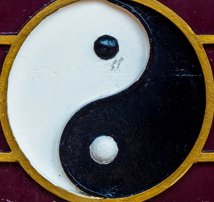
Many people have seen the Tai Chi symbol, which is also commonly called the Yin/Yang symbol or spelled Tai Ji. Yet most people do not understand the meaning behind the symbol except that it represents balance and the polarity of opposites.
First of all, the Tai Chi is depicted as a circle, representing the flow and continuity of life.
The circle is divided into two main sections that resemble two tear drops nestling into one another. There is a thick white part that narrows to a point and there is a thick black part which also narrows to a point. Inside each section are two dots, which represent the polarity of masculine and feminine energies. The white section, which represents masculine, solar energy has a black dot placed in the thickest section to demonstrate that when something reaches its fullest state of “yang” energy, there is still a tiny bit of the opposite contained inside, which will eventually give way to the “yin” energy.
Like a mirror image, the fullest part of the black section, representing feminine, lunar energy, there is a small white dot to convey the presence of “yang” energy waiting to emerge. In the real world, men have female hormones and women have male hormones, but the ratio of yin/yang energy in any person or thing will be what differentiates it from its opposite.
Life is a comparative study and we don’t have a reference or a value for many aspects of life until we know the polarities. We can discuss things in “black and white” terms and wax poetic about searching for love at the “highest mountain to the deepest sea.” We can allude to a hero when we know what a coward is or a sinner in comparison to a saint.
The Tai Chi symbol appears simple, yet it is profound. It reminds us of the relationship and connection to all things. Following the motion of the Tai Chi in a clock-wise movement, it can also represent the seasons of the year and the time of the day. In feng shui applications, we try to make ourselves comfortable in environments that are neither too yin (dark, stagnant, cold) or too yang (bright, moving, hot), just to show a few examples of extremes.
The apex of the white-yang section symbolizes high noon and summertime, while the fullest part of the black-yin section symbolizes midnight and winter. Larger cycles of birth, growth, decay and death are also contained in this full circle.
The goal in every school or style of feng shui is to strike a balance so that an environment is neither too yin or too yang for very long.
| Yang Qualities | Yin Qualities |
| Hot | Cold |
| Bright | Dark |
| High (like ceilings) | Low (like ceilings) |
| Dry | Wet |
| Wide (like a street or hallway) | Narrow (like a street or hallway) |
| Angular/sharp (architecture, furniture) | Rounded, curved (architecture, furniture) |
| Loud | Quiet |
| Open and spacious or even empty | Closed in, cluttered or full |
| Movement (like the ocean or a fan) | Stillness (like a mountain) |
There are many more extrapolations of the Yin Yang symbol and theory; here we have just touched the surface as it relates to physical spaces and how people are almost universally affected by their surroundings.
Author: Kartar Diamond
Company: Feng Shui Solutions ®
From the Feng Shui Philosophical and Metaphysical Musings Blog Series
